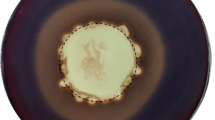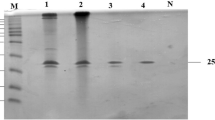Abstract
Xylanases produced from a locally isolated strain of Thermomyces lanuginosus and its mutant derivative were purified to a yield of 39.1 and 42.83% with specific activities of 15,501 and 17,778 IU mg−1 protein, respectively. The purification consisted of two steps i.e., ammonium sulphate precipitation, and gel filtration chromatography. The mutant enzyme showed high affinity for substrate, with a K m of 0.098 mg ml−1 as compared to wild type enzyme showing K m of not less than 0.112 mg ml−1. It was found that pH values of 8.1 and 7.3 were best for activity of the mutant and wild-type-derived enzymes, respectively. The values of pK a of the acidic limbs of both enzymes were the same (5.0 and 4.9, respectively) but the pK a value of the basic limb was slightly increased, indicating the participation of a carboxyl group present in a non-polar environment. Temperatures of 70 and 65°C were found optimal for mutant and wild-derived xylanase, respectively. Enzymes displayed a high thermostability showing a half life of 31.79 and 6.0 min (5.3-fold improvement), enthalpy of denaturation (ΔH*) of 146.06 and 166.95 kJ mol−1, entropy of denaturation (ΔS*) of 101.44 and 174.67, and free energy of denaturation (ΔG*) of 110.25 and 105.29 kJ mol−1 for mutant- and wild-organism derived enzyme, respectively at 80°C. Studies on the folding and stability of cellulase-less xylanases are important, since their biotechnological employments require them to function under extreme conditions of pH and temperature. The kinetic and thermodynamic properties suggested that the xylanase from the mutant organism is better as compared to xylanase produced from the wild type and previously reported strains of same species, and may have a potential usage in various industrial fields.







Similar content being viewed by others
References
Afzal AJ, Ali S, Latif F, Rajoka MI, Siddiqui KS (2005) Innovative kinetic and thermodynamic analysis of a purified superactive xylanase from Scopulariopsis sp. Appl Biochem Biotechnol 120:51–70. doi:10.1385/ABAB:120:1:51
Apel PC, Panaccione DG, Holden FR, Walton JD (1993) Cloning and targeted gene disruption of XYL1, a β-1, 4-xylanase from the maize pathogen, Cochliobolus carbonum. Mol Plant Microbe Interact 6:467–473
Bailey MJ, Biely P, Poutanen K (1992) Inter-laboratory testing of methods for assay of xylanase activity. J Biotechnol 23:257–270. doi:10.1016/0168-1656(92)90074-J
Bhat MK (2000) Cellulase and their related enzymes in biotechnology. Biotechnol Adv 18:355–383. doi:10.1016/S0734-9750(00)00041-0
Chen C, Chen J, Lin T (1997) Purification and characterization of a xylanase from Trichoderma longibrachiatum for xylooligosaccharide. Enzyme Microb Technol 21:91–96. doi:10.1016/S0141-0229(96)00236-0
Clarke AJ, Bray MR, Starting H (1993) β-glucosidase, β-glucanases and xylanases: their mechanism of catalysis. In: Esen A (ed) β-glucosidase, biochemistry and molecular biology. American Chemical Society, Washington DC, pp 27–41
Collins T, Gerday C, Feller G (2005) Xylanases, xylanase families and extermophilic xylanases. FEMS Microbiol Lett 29:3–23
Deising H, Mendgen K (1991) Developmental control of enzyme production and cell wall modification in rust fungi, and defense reactions of the host plant. In: Stahl U, Tudzynski P (eds) Molecular biology of filamentous fungi. VCH-Verlag, Weinham, pp 27–44
Dixon M, Webb EC (1979) Enzyme kinetics enzymes, vol 3. New York, Academic Press, pp 47–206
Eyring H, Stearn AE (1939) The application of the theory of absolute reaction rates of protein. Chem Rev 24:253–270. doi:10.1021/cr60078a005
Ganju RK, Vithayathil PJ, Murthy SK (1989) Purification and characterization of two xylanases from Chaetomium thermophile var. coprophile. Can J Microbiol 35:836–842
Georis J, Esteves FL, Brasseur JL, Bougnet V, Devreese B, Giannotta F (2000) An additional aromatic interaction improves the thermostability and thermophilicity of a mesophilic family 11 xylanase: structural basis and molecular study. Protein Sci 9:466–475
Haltrich D, Nidetzky B, Kulbe KD, Steiner W, Zupancic S (1996) Production of fungal xylanases. Bioresour Technol 58:137–161. doi:10.1016/S0960-8524(96)00094-6
Jiang ZQ, Yang SQ, Tan SS, Li LT, Li XT (2005) Characterization of a xylanase from the newly isolated thermophilic Thermomyces lanuginosus CAU44 and its application in bread making. Lett Appl Microbiol 41:69–76. doi:10.1111/j.1472-765X.2005.01725.x
Kamra P, Satyanarayana T (2004) Xylanase production by the thermophilic mold Humicola lanuginosa in solid state fermentation. Appl Biochem Biotechnol 119:145–157. doi:10.1385/ABAB:119:2:145
Khandeparkar R, Bhosle NB ((2007)) Application of thermoalkalophilic xylanase from Arthrobacter sp. MTCC 5214 in biobleaching of kraft pulp. Bioresour Technol 98:897–903. doi:10.1016/j.biortech.2006.02.037
Kulkarni N, Shendye A, Rao M (1999) Molecular and biotechnological aspects of xylanases. FEMS Microbiol Lett 23:411–456
Li XT, Jiang ZQ, Li LT, Yang SQ, Feng WY, Fan JY, Kusakabe I (2005) Characterization of cellulase free, neutral xylanase from Thermomyces lanuginosus CBS 288.54 and its biobleaching effect on wheat straw pulp. Bioresour Technol 96:1370–1379. doi:10.1016/j.biortech.2004.11.006
Maheshwari R, Bharadwaj G, Bhat MK (2000) Thermophilic fungi: their physiology and enzymes. Microbiol Mol Biol Rev 64:461–488. doi:10.1128/MMBR.64.3.461-488.2000
Matthews BW, Nicholson H, Becktel WJ (1987) Enhanced protein thermostability from site-directed mutations that decrease the entropy of unfolding. Proc Natl Acad Sci USA 84:6663–6667. doi:10.1073/pnas.84.19.6663
Miller GL (1959) Use of dinitrosalisylic acid (DNS) for determination of reducing sugars. Anal Chem 31:426–428. doi:10.1021/ac60147a030
Montes FJ, Battanar E, Catalan J, Galan MA (1995) Kinetic and heat inactivation mechanism of D-amino oxidase. Process Biochem 30:217–224. doi:10.1016/0032-9592(95)95720-4
Munch O, Tritsch D (1990) Irreversible thermoinactivation of glycoamylase from Aspergillus niger and thermostabilization by chemical modification of carboxyl groups. Biochim Biophys Acta 1041:111–116
Nath D, Rao M (2001) pH dependent conformational and structural changes of xylanase from an alkalophilic thermophilic Bacillus sp (NCIM 59). Enzyme Microb Technol 28:397–403. doi:10.1016/S0141-0229(00)00359-8
Nosoh Y, Sekiguchi T (1990) Protein engineering for thermostability. Trends Biotechnol 8:16–20. doi:10.1016/0167-7799(90)90125-H
Prade RA (1995) Xylanases: from biology to biotechnology. Biotechnol Genet Eng Rev 13:101–131
Rajoka MI, Bashir A, Malik KA (1997) Mutagenesis of Cellulomonas biazotea for enhanced production of xylanases. Bioresour Technol 62:99–108. doi:10.1016/S0960-8524(97)00116-8
Rashid MH, Siddiqui KS (1998) Thermodynamic and kinetic study of stability of the native and chemically modified β-glucosidase from Aspergillus niger. Process Biochem 33:109–115. doi:10.1016/S0032-9592(97)00036-8
Ratanachomsri U, Sriprang R, Sornlek W, Buaban B, Champreda V, Tanapongpipat S, Eurwilaichitr L (2006) Thermostable xylanase from Marasmius sp.: purification and characterization. J Biochem Mol Biol 39:105–110
Roberge M, Shareck F, Morosoli R, Kluepfel D, Dupont C (1997) Charatcerization of two important histidine residues in the active site of xylanase A from Streptomyces lividans, a family 10 glycanase. Biochemistry 36:7769–7775. doi:10.1021/bi9703296
Saha BC (2003) Hemicellulose bioconversion. J Ind Microbiol Biotechnol 30:279–291. doi:10.1007/s10295-003-0049-x
Saleem M, Rashid MH, Jabbar A, Perveen R, Khalid AM, Rajoka MI (2005) Kinetic and thermodynamic properties of an immobilized endoglucanase from Arachniotus citrinus. Process Biochem 40:849–855. doi:10.1016/j.procbio.2004.02.026
Siddiqui KS, Azhar MJ, Rashid MH, Rajoka MI (1997) Stability and identification of active site residues of carboxymethylcellulase from Aspergillus niger and Cellulomonas biazotea. Folia Microbiol (Praha) 42:312–318. doi:10.1007/BF02816941
Siddiqui KS, Shamsi AM, Anwar MA, Rashid MH, Rajoka MI (1999) Partial and complete alteration of surface charges of carboxymethylcellulase by chemical modification thermostabilization in water-miscible organic solvent. Enzyme Microb Technol 24:599–608. doi:10.1016/S0141-0229(98)00170-7
Singh S, Madlala AM, Prior BA (2003) Thermomyces lanuginosus; properties of strains and their hemicellulases. FEMS Microbiol Rev 27:3–16. doi:10.1016/S0168-6445(03)00018-4
Sizer IW (1943) Effects of temperature on enzyme kinetics. In: Nord FF, Werkman CH (eds) Advances in enzymology, vol 3. Interscience Publishers, New York, pp 35–62
Subramaniyan S, Prema P (2002) Biotechnology of microbial xylanases: enzymology, molecular biology and application. Crit Rev Biotechnol 22:33–64. doi:10.1080/07388550290789450
Vieille C, Zeikus JG (1996) Thermozymes: identifying molecular determinants of protein structural and functional stability. Trends Biotechnol 14:183–190. doi:10.1016/0167-7799(96)10026-3
Violet M, Meunier JC (1989) Kinetic study of irreversible thermal denaturation of Bacillus licheniformis α-amylase. Biochem J 263:665–670
Ward OP, Moo-Young M (1988) Thermostable enzymes. Biotechnol Adv 6:39–69. doi:10.1016/0734-9750(88)90573-3
Xiong H, Nyyssola A, Janis J, Pastinen O, von Weymarn N, Leisola M, Turunen O (2004) Characterization of the xylanase produced by submerged cultivation of Thermomyces lanuginosus DSM 10635. Enzyme Microb Technol 35:93–99. doi:10.1016/j.enzmictec.2004.04.003
Acknowledgments
The work described is part of the Ph.D. research work of Syed Ali Imran Bokhari. This work was financed in part by Higher Education Commission, Government of Pakistan, through Indigenous Ph.D. 5000 fellowship programme. Technical assistance of Mr. Maqsood Ahmed is appreciated.
Author information
Authors and Affiliations
Corresponding author
Rights and permissions
About this article
Cite this article
Bokhari, S.A.I., Latif, F. & Rajoka, M.I. Purification and characterization of xylanases from Thermomyces lanuginosus and its mutant derivative possessing novel kinetic and thermodynamic properties. World J Microbiol Biotechnol 25, 493–502 (2009). https://doi.org/10.1007/s11274-008-9915-z
Received:
Accepted:
Published:
Issue Date:
DOI: https://doi.org/10.1007/s11274-008-9915-z




